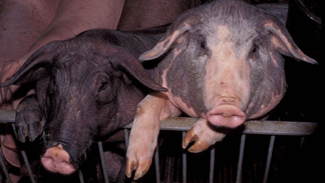The genetic variability of pigs is greater than was thought

The porcine species is much more variable than was once thought. Researchers have found a genetic variability for the gene FABP4 (which is involved in the quantity of fat that the animal deposits) ten times greater than that found in humans and similar to that of wild, undomesticated species. In addition they have discovered that the Iberian pig is very variable.
The domestication of animals and plants was one of the key events in the history of humanity, since it allowed us to ensure a constant source of food not determined by the vicissitudes inherent in hunting or in gathering in the wild. Most of the species that we eat today were domesticated approximately 7,000 -10,000 years ago. In case of the pig, it is said that this species was domesticated in various places, both on the European continent and in Asia.
One of the aspects that have concerned researchers most is how this process, domestication, has affected genetic variability, since it is to be expected that domestic species show less variability than their wild ancestors. Besides, knowing the genetic variability is fundamental to establishing conservation programmes, and there are several thousands of breeds of domestic animals in danger of extinction, according to the FAO.
Researchers at the UAB and the University of Barcelona have just published, in December's issue of the magazine Genetics (<http://www.genetics.org/>), research that shows that the porcine species is much more varied than was expected. For the gene FABP4, which is involved in the quantity of fat that an animal deposits, these researchers have found a genetic variability that is ten times greater than the variability found in humans for example, and similar to that of wild, undomesticated species. But, besides, they have found that the Iberian pig is very variable, and that it alone contains almost half the genetic variability of this gene described in the whole species.
This result is very unexpected, since the Iberian pig is quite a small population, relative to all porcine breeds. On the other hand, most genetic studies up to date have found a relation between the geographical origin of the breed and genetic variability; for example, Asian breeds tend to be more similar to each other than to European breeds. This seems not to be true for this gene, and that some variants of the Iberian pig are similar to those found in Asian breeds.
This work is of the first in-depth variability studies of a porcine gene, including both domesticated breeds and wild boar, and has found a very unexpected genetic pattern. In addition, it also shows the importance of maintaining the genetic heritage of the Iberian pig.
References
"Unexpected High Polymorphism at the FABP4 Gene Unveils a Complex History for Pig Populations". Ana Ojeda, Julio Rozas, Josep M. Folch, and Miguel Pérez-Enciso. Genetics Society of America. DOI: 10.1534/genetics.106.063057.


